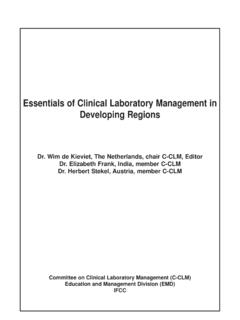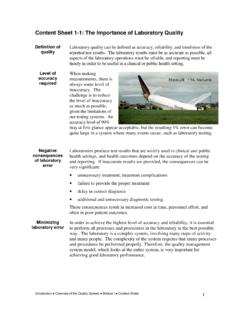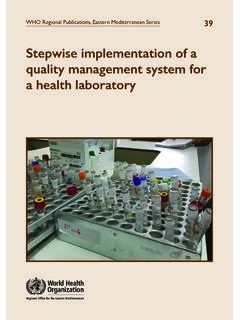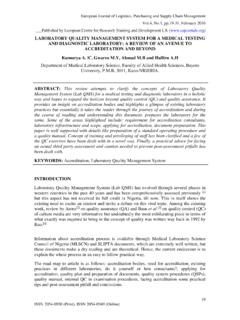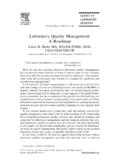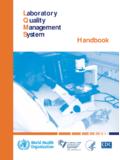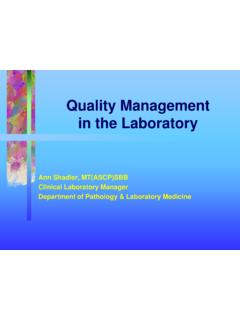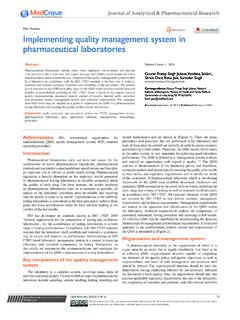Transcription of Vienna International Centre, PO Box 500, 1400 …
1 *0858836*Guidance for the Implementation of aQuality management system inDrug Testing LaboratoriesVienna International Centre, PO Box 500, 1400 Vienna , Austria Tel.: (+43-1) 26060-0, Fax: (+43-1) 26060-5866, nations publicationISBN 978-92-1-148239-3 Sales No. in March 2009 440 FOR united nations USE ONLYA commitment to quality and continuous improvementPhoto credits:UNODC Photo Library; UNODC/Ioulia Kondratovitch; Alessandro and Scientific SectionUnited nations office on drUgS and crimeViennaGuidance for the Implementation of aQuality management system inDrug Testing LaboratoriesA commitment to quality and continuous improvementUNITED NATIONSNew York, 2009 AcknowledgementsThis manual was produced in the laboratory and Scientific Section (LSS) under the supervision of Justice Tettey. The contribution of all staff (core team: Iphigenia Naidis, Satu Turpeinen) is gratefully acknowledged.
2 LSS wishes to express its thanks to Dr. Pirjo Lillsunde, drug Research Unit, National Public Health Institute (KTL), Finland, who authored the first draft that formed the basis of the present manual. LSS also wishes to thank the members of the Standing Panel of the UNODC s International quality Assurance Programme, Dr. Robert Anderson, Dr. Robert Bramley, Dr. David Clarke, and Dr. Pirjo Lillsunde, for reviewing and finalizing the manuscript.*Finally, EA European Co-operation for Accreditation, through its laboratory Committee, is acknowledged for its valuable comments. *Contact details of named individuals can be requested from the UNODC laboratory and Scientific Section ( Box 500, 1400 Vienna , Austria). united nations PUBLICATIONS ales No. 978-92-1-148239-3 This publication has not been formally Page1.
3 FOREWORD: PURPOSE OF THE 12. INTRODUCTION .. 43. quality management 5 quality policy .. 6 quality manual .. 64. management 7 laboratory organization .. 7 Document control .. 8 Review of client requests .. 9 Subcontracting of analytical work .. 9 Purchasing services and 9 Service to 10 10 Corrective and preventive 10 Control of records/Chain of custody .. 11 Internal audit .. 12 management 135. TECHNICAL 14 Introduction .. 14 Personnel .. 14 Accommodation and environmental 15 Health and 16 Test methods, method validation and procedures .. 17 Equipment .. 22 Reference standards, materials and 24 Handling of test items .. 26 Reporting the 28 quality control, proficiency testing and inter- laboratory 30 References.
4 31 Annex Model for a quality manual .. 3311. Foreword: Purpose of the manualLaw enforcement authorities and other clients of drug analysis laboratories, for example, police, customs, prosecutors and defence solicitors, need results that are:reliable; "valid; "based on standard procedures; "compatible with results in other laboratories; "compliant with the evidentiary standards of the respective judicial, "administrative and legal systems;obtained in an effective and efficient manner in the required timescale; "value for money. "The quality of the analyses and results of such laboratories have significant implica-tions for the justice system , law enforcement, crime prevention and health policy, as well as for the International harmonization and worldwide exchange and coordination of drug information and data.
5 [1]The compatibility and acceptance of laboratory results between countries is facili-tated by their compliance with EN ISO/IEC 17025:2005 (ISO 17025) [2], the inter-national quality standard for testing and calibration laboratories, and the associated ILAC recommendations G19:2002 for forensic science laboratories [3]. Compliance with ISO 17025 also ensures conformity with the requirements of ISO 9001 that are relevant to drug testing laboratories. However, compliance with ISO 9001 alone is not a substitute for compliance with ISO 17025, as it does not address the technical competence of the testing guidelines that follow are specifically for drug testing laboratories and are based on the general principles of the ISO 17025 standard. They also take account of the UNODC Recommended Guidelines for quality Assurance and Good laboratory Practice [4], SWGDRUG Recommendations [5], the requirements of the American Society of crime laboratory Directors laboratory Accreditation Manual [6], SOFT/AAFS Forensic Toxicology laboratory Guidelines [7] and European laboratory Guidelines for Legally Defensible Workplace drug Testing.
6 [8, 9] 2 Guidance for the Implementation of a quality management system in drug Testing LaboratoriesDedication to quality is the fundamental principle of a forensic laboratory . The aim of this document is to provide guidance to deliver high quality in a forensic labora-tory, use the appropriate techniques to find the answers and to improve it constantly. It is a how to do document and includes some areas that are not explicitly covered in depth by ISO 17025. It is intended to serve as an introduction to laboratory quality management systems and to provide practical guidance to national authorities and analysts for the imple-mentation of such systems based on best practice in the laboratory . Best practice may vary between laboratories because the resources at their disposal and the legal requirements are different.
7 For example, on an International scale, the state-of-the-art in instrumentation may stipulate LC-MS-MS as the basis for best practice, but this equipment is unavailable in many laboratories which nevertheless produce good results. Also, in some jurisdictions it may be necessary to quantify drugs or identify specific isomers while it may not be required in other countries. Best practice should therefore be interpreted as the best achievable practice within the laboratory and jurisdiction concerned, as long as the work carried out meets the requirements in this document. There are different ways of achieving the end result and these guidelines will assist laboratory managers to ensure that their way is at an interna-tionally acceptable of all drug testing laboratories with the guidelines that follow is essential to ensure the harmonized performance of drug testing laboratories worldwide.
8 These guidelines can also be used as a basic guide not only for laboratories but also for auditors and inspectors in the evaluation of drug testing laboratories during the accreditation process. External accreditation to ISO 17025 is the process by which an authorized accredita-tion body formally recognizes that a laboratory is competent to carry out specific tasks. In the accreditation process, the laboratory demonstrates that its management , operations, personnel, procedures, equipment, accommodation, security, and health and safety procedures meet established quality standards. While it may require a significant investment of resources, it would provide laboratory management , law enforcement authorities and other clients with added confidence in the performance of the laboratory . External accreditation is therefore an appropriate goal in the development of a quality management system and many drug testing laboratories in several countries have now been future, it is possible that only accredited drug testing laboratories will be authorized to function as forensic toxicology laboratories or as police crime laboratories.
9 UNODC provides support to laboratories in introducing and implementing a quality management system through a number of initiatives, including the provision of reference samples of controlled substances, laboratory manuals on recommended Guidance for the Implementation of a quality management system in drug Testing Laboratories 3methods, training opportunities and the International Collaborative Exercises scheme, and by promoting and facilitating the exchange of information, material and data. [10]Throughout the manual, examples are given to clarify various points made. These are preceded by the phrase for example . Where this occurs, the examples given are not exhaustive but merely intended to illustrate the respective IntroductionLaboratories following the practical guidelines described in this document should meet the requirements of ISO 17025.
10 The guidelines are based on theoretical con-siderations as well as practical experience gained in the laboratory accreditation process. They are designed to ensure the correct identification of substances, to ensure that the processes undertaken will stand up to legal scrutiny and to provide safeguards to protect the rights of individuals. The aim of the guidelines is to improve the quality of laboratory services and to define common quality assurance is drawn to both technical requirements (including the importance of trained staff, appropriate accommodation and environmental conditions, method validation, access to required equipment and reference standards, quality control and the reporting of results) and management requirements (including document control, responsiveness to the needs of the client, preventive and corrective actions, the need for regular audits of compliance with the quality management system and continuous improvement).










